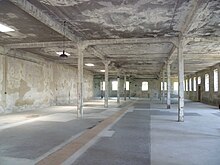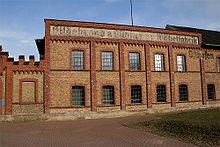Osthofen concentration camp
| Osthofen | |
|---|---|
| Nazi concentration camp | |
 Entrance to concentration camp memorial, 2019. | |
| Coordinates | 49°42′28″N 08°19′33″E / 49.70778°N 8.32583°ECoordinates: 49°42′28″N 08°19′33″E / 49.70778°N 8.32583°E |
| Location | Osthofen, Germany |
| Operated by | Hesse Political Police |
| Commandant | |
| Original use | paper factory |
| Operational | March 1933–July 1934 |
| Inmates | Political prisoners, Jehovah's Witnesses, Seventh-Day Adventists, Jews |
| Number of inmates | 3,000 |
| Notable inmates | Max Dienemann Carlo Mierendorff Max Tschornicki |
| Website | http://projektosthofen-gedenkstaette.de |
The Osthofen concentration camp (German: KZ Osthofen) was an early Nazi concentration camp in Osthofen, close to Worms, Germany. It was used from March 1933 to July 1934 and is now a memorial site.
History[]
The Osthofen concentration camp's official history begins with a decree by the State Commissar for the Police in Hesse, Werner Best, on 1 May 1933. Anyone arrested for political reasons in Hesse for more than a week or expected to be imprisoned for more than a week was ordered to be sent to Osthofen.[1] However, the camp had already been in operation for longer. After the 28 February 1933 Reichstag Fire Decree, civil liberties in Germany became restricted, and large numbers of Communists were arrested. On 6 March,[2] the empty former paper factory in Ziegelhüttenweg was confiscated from its legal owner, Jewish businessman Karl Joehlinger.[3] Large groups of prisoners began to be sent to the camp from 13 March 1933, with most of the early prisoners Communists or Social Democrats. From summer of 1933, also non-political Jews, Jehovah's Witnesses, Seventh-Day Adventists and others were imprisoned.[1]
The camp was closed in July 1934 as a result of a centralisation of the concentration camps directed by Heinrich Himmler,[4] and the 13 last prisoners were moved to other camps and prisons including Dachau.[5]
Administration and guards[]
The camp was under the direction of the Hesse Political Police,[2] which later became part of the Gestapo.[1] , a SS Sturmbannführer and the local Osthofen Nazi Party chairman, was made honorary camp leader on orders of Werner Best.[2] Camp doctor was , who declared every single new arrival healthy and medically fit for imprisonment even if they had been mistreated.[6] The camp guards were at first drawn mostly from local SA and SS men turned auxiliary police[1] (95 SA and 99 SS, of which 55 served each day) but the SA were replaced by SS in autumn of 1933, significantly worsening conditions for the prisoners.[6] None of the guards were prosecuted for their actions in the camp after 1945.[1]
The existence of the concentration camp was not a secret, and was at the time widely commented on in the press, both locally and internationally.[7] The New York Times reported on the camp and its imprisonment of Jews in August 1933.[8] The camp sign, painted on the building in large letters, was clearly visible from passing trains.[7]
Conditions in the camp[]

Osthofen usually held around 200 prisoners at a time, and approximately 3,000 people were imprisoned there over the existence of the camp,[1] usually for two to six weeks,[7] but ranging from one week to one year.[9] The prisoners were used as unpaid labourers, often for the benefit of D'Angelo or other party members.[1] Although living conditions and hygiene were extremely primitive (at first, prisoners had to sleep on the concrete floor), none of the inmates died in the camp,[1] but many became sick and contracted chronic urinary tract diseases.[9] The prisoners were routinely abused and humiliated, especially Jews. For example, Ernst Katz was severely beaten on Yom Kippur and forced to eat pork after he regained consciousness.[10] The SPD politician Carlo Mierendorff was forced to straighten nails that his fellow prisoners had to bend.[4] In a nearby "Camp II", which was used for aggravated detention, prisoners had to spend the nights in wire cages, with lights on that made sleep difficult.[9][4]
Site history and legacy[]

The main building was erected in 1872 as a paper factory owned by Gustav Rumpel. In 1908, it was extended with another factory hall, under the ownership of Joseph Kahn. The paper factory was closed in the 1930s. After the use as a concentration camp, it became a furniture factory from 1936 to 1976.[3]
Former prisoners, supported by the Union of Persecutees of the Nazi Regime, started efforts to commemorate the history in 1972, which was at the time opposed by locals. A first memorial plaque was installed in 1978.[11] A first book with "materials about an almost forgotten concentration camp"[12] was compiled in 1979 by former Buchenwald detainee .[7] After further activist involvement by the youth wing of the German Trade Union Confederation and others, the camp building became a protected monument in 1989.[7] The state of Rhineland-Palatinate bought the site in 1991 and turned it into a memorial,[3] which was completed in 2004.[7]
Literary adaptation[]
In her 1942 novel The Seventh Cross (adapted as a film in 1944), Anna Seghers describes a fictitious "Westhofen" concentration camp located in the same area. Seghers had met Max Tschornicki, one of the two inmates who escaped from Osthofen, in Paris.[5] While the novel has been called a "memorial" to the Osthofen inmates[4] and realistically describes the political persecution in Rhenish Hesse,[7] the plot of The Seventh Cross, set in 1937, is inspired by an escape from Sachsenhausen concentration camp.[13]
Notable prisoners[]
- Max Dienemann, German rabbi[14]
- Carlo Mierendorff, German SPD politician and member of parliament, imprisoned from 21 June 1933.[15]
- Max Tschornicki, German Jewish lawyer and resistance member, escaped from the camp on 3 July 1933.[7]
References[]
Footnotes[]
- ^ Jump up to: a b c d e f g h Arenz-Morch 2009, p. 150.
- ^ Jump up to: a b c Meyer & Roth 2005, p. 181.
- ^ Jump up to: a b c Ritter 2020.
- ^ Jump up to: a b c d Arenz-Morch 2009, p. 151.
- ^ Jump up to: a b Meyer & Roth 2005, p. 184.
- ^ Jump up to: a b Meyer & Roth 2005, p. 183.
- ^ Jump up to: a b c d e f g h Landeszentrale Politische Bildung 2010.
- ^ TIMES 1933.
- ^ Jump up to: a b c Meyer & Roth 2005, p. 182.
- ^ Wünschmann 2015, p. 95.
- ^ Gedenkstätte Osthofen 2020.
- ^ Grünewald 1979.
- ^ Adeoso 2018.
- ^ Jewish Telegraphic Agency 1939.
- ^ Werner 2019.
Bibliography[]
- Adeoso, Marie-Sophie (15 April 2018). "Wo Georg Heislers Flucht begann" (in German). Retrieved 8 September 2020.
- Arenz-Morch, Angelika (2009). "Osthofen". In Megargee, Geoffrey P. (ed.). The United States Holocaust Memorial Museum encyclopedia of camps and ghettos, 1933-1945. Volume 1, Early camps, youth camps, and concentration camps and subcamps under the SS-Business Administration Main Office (WVHA). Translated by Pallavicini, Stephen. Bloomington: Indiana University Press. pp. 150–151. ISBN 978-0-253-00350-8. OCLC 644542383.
- Grünewald, Paul (1979). KZ Osthofen: Material zur Geschichte eines fast vergessenen Konzentrationslagers (in German). Röderberg-Verlag. ISBN 978-3-87682-709-4.
- Meyer, Hans-Georg; Roth, Kerstin (2005). "Osthofen". In Benz, Wolfgang; Distel, Barbara; Königseder, Angelika (eds.). Der Ort des Terrors: Geschichte der nationalsozialistischen Konzentrationslager (in German). 2. C.H.Beck. pp. 181–184. ISBN 978-3-406-52962-7.
- Ritter, Barbara (2020). "Papier- und Möbelfabrik - heute Gedenkstätte KZ in Osthofen | Rhein-Neckar-Industriekultur e.V." www.rhein-neckar-industriekultur.de. Retrieved 16 August 2020.
- TIMES, Wireless to THE NEW YORK (30 August 1933). "Nazis Imprison Jews in Concentration Camp After French Paper Charges Abuses There". The New York Times. ISSN 0362-4331. Retrieved 10 September 2020.
- Werner, Marie-Christine (21 June 2019). "21.6.1933 Carlo Mierendorff wird ins KZ Osthofen eingeliefert". SWR2 Zeitwort (in German). SWR2. Retrieved 16 August 2020.
- Wünschmann, Kim (16 March 2015). Before Auschwitz. Harvard University Press. ISBN 978-0-674-42558-3.
- Landeszentrale Politische Bildung (2010). "The Osthofen Concentration Camp Memorial" (PDF). Blätter zum Land Extra.
- Gedenkstätte Osthofen (2020). "Erstes Gedenken". Gedenkstätte KZ Osthofen (in German). Landeszentrale Politische Bildung, Rheinland-Pfalz.
- Jewish Telegraphic Agency (14 April 1939). "Rabbi Dienemann Dies in Palestine; Had Been Beaten in Nazi Camps". Retrieved 13 September 2020.
External links[]
- Nazi concentration camps in Germany
- Museums in Rhineland-Palatinate
